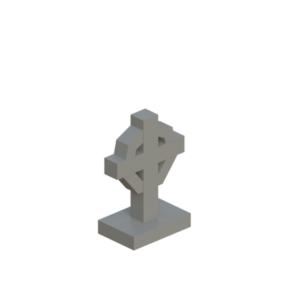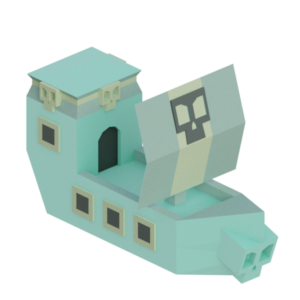Background
The Battle of Polytopia’s community is quite active, and regularly comes up with wacky and wonderful tribe ideas for expanding the game. As the subreddit reached 15,000 subscribers, a fan art contest was held which presented a good opportunity to present a new tribe concept.
Conception
Undead factions are a staple of many games, and in particular, I was inspired by The Scourge from Warcraft, Terraria’s Solar Eclipse and Pumpkin Moon events, and the Ermor nation from the Dominions series. The latter in particular presents a new way of playing the game, as the nation must expand rapidly or eventually die, as if out running its own doom. Applying this concept to Polytopia seemed interesting, with a faction that doesn’t rely on production, but rather consumes population to generate its units, and replenishes its population by killing enemy units.
Gameplay
The tribe hasn’t been fully fleshed out with regards to infrastructure and resources so it’s not known how feasible this concept is. The overall theme is that of an enemy that just consumes and destroys, so farming, lumber huts, and infrastructure in general plays no role for this tribe.
The nitty-gritty specifics are:
- The capital is ” The Necropolis”.
- Villages don’t become cities, they only add three population to the nearest city.
- Conquered enemy cities are captured as normal.
- Buying technologies and building units consumes population.
- Captured enemy cities that have their populations depleted turn into ruins.
- Death caps (the fruit) provide a free 1 population.
- Animals aren’t hunted, only transformed into riders.
- Each enemy unit killed produces 1 population for the nearest city.
Clearly, these are big economic disadvantages for this tribe, but the units are powerful to compensate.
City Buildings
The city buildings are all graveyard themed, with a mausoleum, two styles of headstone, a coffin and an urn.
The castle* is a short obelisk with grim reaper statues and scythes on all sides.
*“Castles” in the game are pyramidal buildings with crowns that denote the original capital.






Units
Zombie
Replacing the warrior, the zombie is the standard issue unit, consuming 1 population to produce.

Hell Hound
Replacing the rider, the hell hounds are also the game (native animals) to the Necropolis. Similar to the Elyrion, hell hounds aren’t hunted, but instead converted into their respective units.

Skeleton
Replacing the archer, skeleton’s are often portrayed as archers. I’m not sure of the origin, but I do know Minecraft as a notable case. Skeletons heal when nearby friendly units take damage. They cost 2 population.

Ghost
The ghost replaces the defender unit. In keeping with the theme of an undead faction that consumes itself and must expand rapidly, having a defensive unit doesn’t make sense. The ghost is the answer, as the anti-defender, it lowers the defense of surrounding enemy units to 1 through fear. They cost 2 population.

Vampire
Replacing the swordsman, the vampire restores health to itself whenever it deals damage. In addition, it can cross shallow waters without the use of a port by transforming into a bat (albeit become more vulnerable). They cost 3 population.

Necromancer
The necromancer is the Necrosus equivalent of the mind bender. It has a passive area of effect where enemy units adjacent to it that die are instead converted into their Necrosus equivalents and join the army of the undead. Additionally, they can convert frozen enemy units into the undead. They cost 3 population.

Knightmare
The knightmare is a ghostly horse with a headless horseman from the Legend of Sleepy Hollow, brandishing a sword. It is invisible to enemy units if standing in a forest. They cost 4 population.

Dracolich
Replacing the catapult is the animated remains of a dragon who didn’t feel like dying. It can fly, much like the fire dragon, but is more fragile, and does not deal damage. Instead, this undead creature has also mastered ice magic, freezing enemy units at long range. They cost 4 population.

Lich King
The Lich King is the Necrosus super unit. With powers over the icy embrace of death, any unit that is damaged by the Lich (whether in defense or offense) is frozen. The Lich also has the power to transform all adjacent enemy units that are frozen into the undead army.

Flying Dutchman
The dutchman is the replacement for the battleship. An eerie, glowing, hovering ship that haunts the seas, the dutchman cannot be seen by enemies unless it is directly adjacent to one of their units. They cost 5 population from the nearest city.

Music
Of course, each tribe has its own theme music, and Necrosus are no exception.
Tone Colours
- A delayed reverb 16 bit kick and hi-hat that is present throughout the track that gives an atmospheric tick in the background.
- Main drum line with 16 bit samples for a kick, snare, and “blip” for a hi-hat. It kicks in alongside the main melodic line in the first section and ramps up in volume. In the remaining sections, it remains thumping along.
- A percussive synth bass line.
- The main melodic line and the intro chords which has a bell-like colour.
- Finally, of course, no evil, halloween themed villain would be complete without an organ which dominates the second section, and recurs in the third.
Composition
- The first section begins with chords in the main bell instrument. The bass line kicks in for two bars before the main melody and the main drums. The drums increase in volume before silencing alongside the main melody, as a rising limb of the track.
- The second section begins in the silence that ends the first with only the bass line. Then the organ’s line kicks alongside the main drums, before the main melody begins again alongside the organ which forms the climax of the track and ends the second section.
- The third section begins at the end of the second phrase of the organ. This section functions as a descending limb, with only the main drums and the bass line present towards the end. Motifs from the bell and organ melodies recur and the former concludes the track as the drums and bass line drop out.
Harmony & Melody
The three things I had to include for this track are: a key in D, minor-major 7 chords, and the Locrian mode.
Harmony was mainly limited to the intro chords which sets the tone for the rest of the track well. No other chord frightens like a DmM7, and D minor is widely regarded as the darkest musical key.
The bass line and the main melody were written in D Locrian, which is notorious for being difficult as there is no resolution to a perfect fifth. But I think it worked beautifully in this case as the lines constantly ascended in rhythm and terminated at diminished fifths and minor sixths. The lack of melodic “rest” or resolution is a reflection of the tribe’s concept as a relentlessly enemy. This also gives the organ lines extra power as they do indeed resolve.
Hip hop heads with keen ears may recognise the organ line as inspired by Tyler the Creator’s “Rusty“, a powerful ascending pentatonic line that sails over the brilliant composition.
